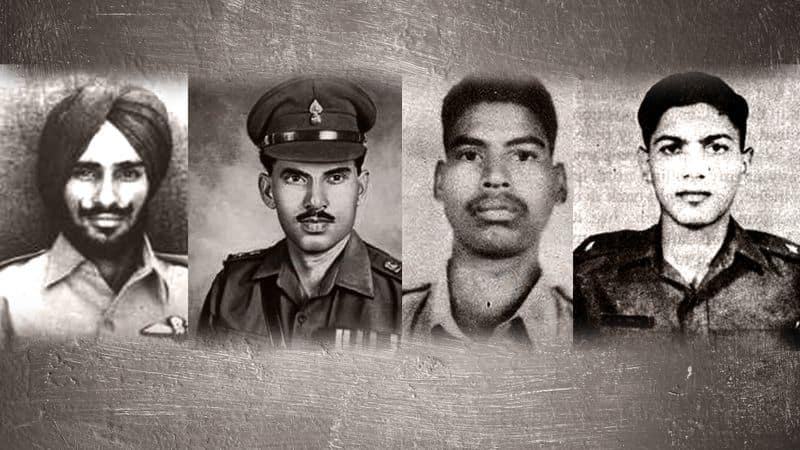In 1971, India fought its first two-front war, in which the personal exceptional bravery of the men and officers in all domains of warfare including sea, land, and air that ensured victory
New Delhi: In 1971, India fought its first two-front war in the actual sense that it fought on both eastern and western front. It also meant that its forces were stretched on both sides as campaigns were launched under Field Marshal SAM Manekhaw on both sides. It was also the personal exceptional bravery of the men and officers in all domains of warfare including sea, land, and air that ensured victory.
MyNation takes a look at the bravest of the brave or the Param Virs who ensured victory for the motherland.
Flying Officer Nirmaljit Singh Sekhon, PVC (Posthumous)
(17 July 1945- Dec 14, 1971)
Flying Officer Nirmal Jit Singh Sekhon was born on July 17, 1945, in the village of Issewal in Ludhiana of Punjab. He was inspired by the experiences of his father who served in the IAF and later retired as (Honorary) Flight Lieutenant.
Flying Officer Singh studied in Khalsa HIgh school near Ludhiana and later joined Dayalbagh Engineering college in Agra in 1962. He left the engineering course to join the IAF. He was commissioned into the IAF on 04 June 1967 as a fighter pilot and joined No. 18 Squadron.
During the India-Pakistan War of 1971, Flying officer Nirmal Jit Singh Sekhon was a pilot of a Gnat detachment (18 Squadron, known as “The Flying bullets”) based at Srinagar.
Fg Offr Sekhon, despite being, unfamiliar with the terrain, fought successive waves of intruding Pakistani aircraft with valour and determination. On December 14, 1971, the Srinagar airfield was attacked by six Pakistan Air Force F-86 jets of 26 Sqn from PAF base in Peshawar.
As soon as the first aircraft was attacked, he rolled for take-off as No. 2 in a two-Gnat formation, with Flt Lt Ghumman in lead, just as the first bombs were falling on the runway. He could not start immediately as the dust from the first Gnat was clearing.
In spite of the immense danger of attempting to take off during an attack, Fg Offr Sekhon took off and immediately engaged a pair of attacking Sabres. In the ensuing air battle, he made a direct hit on one Sabre and set another ablaze.
He succeeded in damaging and knocking off two of the enemy aircraft. Fg Offr Sekhon, after being hit, was advised to return to the base; he attempted a last-minute ejection, which did not prove successful, as his canopy was seen to fly off.
His aircraft crashed and he was martyred but his sacrifice did not go in vain. The Sabre jets, unable to complete their attack on the town and its airfield, immediately retreated and fled the scene.
For his true heroism, exemplary courage, flying skill, and determination, he was awarded India’s highest wartime medal for gallantry, the “Param Vir Chakra”. Fg Offr Sekhon was the first officer of the IAF to have received the nation’s highest gallantry award.
2nd Lt Arun Khetarpal PVC
(Oct 14,1950- Dec 16 ,1971)
Second Lieutenant Arun Khetarpal was born on October 14, 1950 in Pune, Son of Lt Col (later Brigadier) ML Khetarpal and Mrs Maheshwari. He studied from the Lawrence School, Sanawar located in Kasauli hills in Himachal Pradesh and joined the National Defence Academy in June 1967. He belonged to Foxtrot Squadron and was the Squadron Cadet Captain of the 38th Course.
He joined the Indian Military Academy later and was commissioned into the 17 Poona Horse on June 13, 1971. During 1971 war, 2nd Lt Khetarpal was undergoing the Young Officers’ Course at Ahmednagar at that time and was recalled from the course to join his unit to take part in the famous “Battle of Basantar” in the Shakargarh sector.
During the India-Pakistan War of 1971, the 17 Poona Horse was assigned to the command of the 47th Infantry Brigade, which was involved in the Battle of Basantar in the Shakargarh sector. The Brigade had to establish a bridgehead across the River Basantar. On December 15, the brigade had captured its objective; it was filled with extensive mines by the enemy, preventing deployment of tanks of Poona Horse. It was a joint operation by 17 Horse, 4 Horse (two armoured Regiments), 16 Madras and 3 Grenadiers, the 17 Poona Horse decided to push through the minefield.
On December 16, Pakistan launched counter-attacks under the cover of a smokescreen at Jarpal, targeting the ‘B’ Squadron. 2nd Lt. Khetarpal, who was in ‘A’ squadron and was stationed close by, responded promptly, along with the rest of his regiment. 2nd Lt Khetarpal rushed to meet the Pakistani armour and launched his counter attack. He was able to subdue the enemy advance with his tanks successfully. However, the commander of the second tank Lt Ahlawat got killed. Alone in charge, 2nd Lt Khetarpal continued his attack on the enemy. He attacked the incoming Pakistani attack and tanks taking down an enemy tank in the process. However, the Pakistani forces regrouped and counterattacked. In the ensuing tank battle, 2nd Lt Arun Khetarpal with his 2 remaining tanks fought off and destroyed 10 enemy tanks.
During the fierce tank battle 2nd Lt Khetarpal’s tank was hit by enemy fire. His final words over the radio to a superior officer who had ordered him to abandon his burning tank were, “No Sir, I will not abandon my tank. My main gun is still working and I will get these bastards.” Then he set about destroying the remaining enemy tanks. The last enemy tank, which he shot, was barely 100 metres from his position. At this stage, his tank received a second hit and the shell entered into the tank through its cupola, ripping his stomach.
The enemy could not get the passage it was so desperately seeking and not one enemy tank could get past him.
2nd Lt Khetarpal’s body and his tank “Famagusta” were captured and were later returned to the Indian army. On 17th December, 1971, 2nd Lt Khetarpal was cremated near Samba district and his ashes were sent to his family.
2nd Lt Arun Khetarpal was given the nation’s highest gallantry award, Param Vir Chakra, for his supreme sacrifice.
Lance Naik Albert Ekka PVC
(Dec 27, 1942-Dec 3, 1971)
Albert was born on December 27, 1942, in an Oraon Christian family in Zari village of Jharkhand.
After his early education, he was commissioned in Bihar Regiment at the age of 20. In 1968, he was transferred to 14 Guards to overtook counterinsurgency operations in the Northeast but rushed to Bangladesh with start of 1971 war.
On December 3, 1971, he was directed to capture the Pakistani stronghold of Gangasagar in Bangladesh, which was just 6.5 kilometres west of Agartala, Tripura.
Capturing the Pakistani fort of Gangasagar was critical for the advancement of Indian troops towards Akhaura as it was aimed to ease Indian troops way to Dhaka. As part of the strategy, two companies of the 14 Corps launched an assault on the Gangasagar railway station, while the other two undertook operations capturing other parts of this town.
About 100 yards away from Pakistan troops, the Indian bravehearts came under heavy firing from automatic machine guns. Indian forces, despite increasing fatal casualties and decreasing strength, propelled themselves further and were eventually managed hand-to-hand combat with Pakistan.
During the battle, Lance Naik Albert noticed that a Pakistani light machine-gun was inflicting serious damage on the Indian forces. He captured the mighty Pakistani light machine-gun which helped Indian troops to win Pakistani fort.
He refused an evacuation attempt as he was aiming to take down the Pakistani MMG to avoid more damage to Indian soldiers.
It was his alone efforts that Indian Army achieved their objective and took control of Gangasagar from the Pakistani forces. With this, the Indian Army also restricted the advancement of Pakistani forces towards Agartala, a major hub for Bangladesh liberation operations.
Major Hoshiar Singh Dahiya
(5 May 1936 - 6 December 1998)
Major Hoshiyar Singh Colonel (retd) was born on May 5, 1936 in village Sisana, district Sonipat, Haryana. After his schooling in Rohtak, Hoshiyar Singh joined the Indian Army. He was commissioned in Grenadiers Regiment on 30 June 1963 as an officer. He was at first assigned duty as NEFA and during 1965 war, he was posted at Rajasthan. In the 1971 India-Pakistan War, he was awarded the Param Vir Chakra on December 17, 1971.
Three Grenadiers under the command of Lt Col V P Airy made gains in the first 10 days of the war. The 3rd Battalion of the Grenadiers Regiment was in the forefront of the advance of 54 Inf. Div. in Shakargarh sector on the western front on the night of December 5. On the15th, it was tasked to build a bridgehead across the Basant river, despite under the defense by Pakistan and covered with deep minefields.
The hero of the war Major Hoshiar Singh, Commander of 'C' Company, launched an attack across the enemy minefield on Jarpal, and suffered heavy casualties. Despite suffering heavy losses, they managed to decimate the enemy bunkers.
On December 17, the enemy launched another attack with heavy artillery in support. Wounded seriously, Major Singh went alone from trench to trench, rushed to the enemy machine gun pit and operated the gun inflicting heavy casualties on the enemy.
The Pakistanis faced a befitting reply from India, leaving behind 85 dead, including their Commanding Officer - Lt Colonel Mohammed Akram Raja and three other officers. Throughout this operation, Major Singh displayed the gallantry, grim determination and indomitable spirit for which he awarded Param Vir Chakra.
Last Updated Dec 16, 2018, 1:30 PM IST











![Salman Khan sets stage on fire for Anant Ambani, Radhika Merchant pre-wedding festivities [WATCH] ATG](https://static-ai.asianetnews.com/images/01hr1hh8y86gvb4kbqgnyhc0w0/whatsapp-image-2024-03-03-at-12-24-37-pm_100x60xt.jpg)
![Pregnant Deepika Padukone dances with Ranveer Singh at Anant Ambani, Radhika Merchant pre-wedding bash [WATCH] ATG](https://static-ai.asianetnews.com/images/01hr1ffyd3nzqzgm6ba0k87vr8/whatsapp-image-2024-03-03-at-11-45-35-am_100x60xt.jpg)



